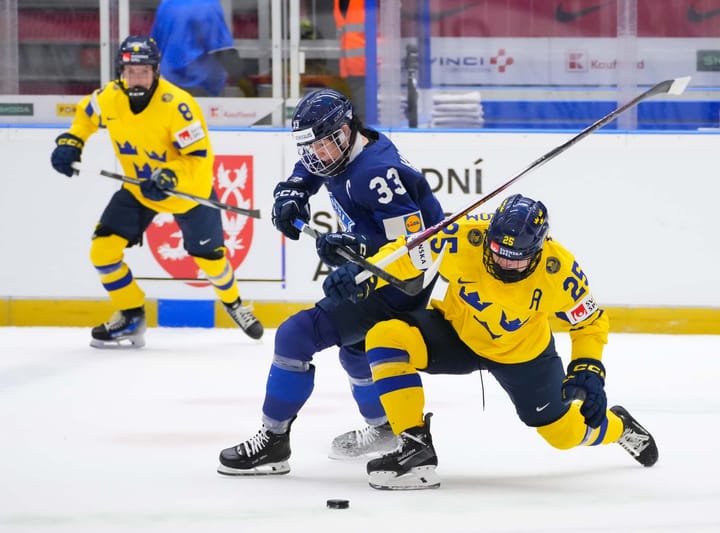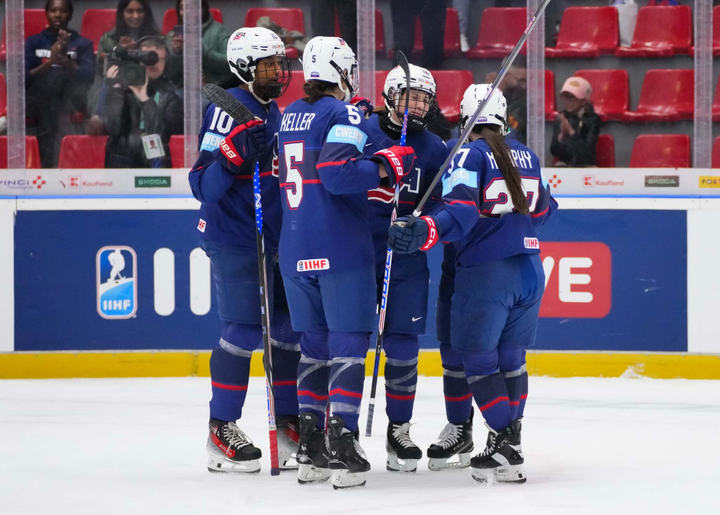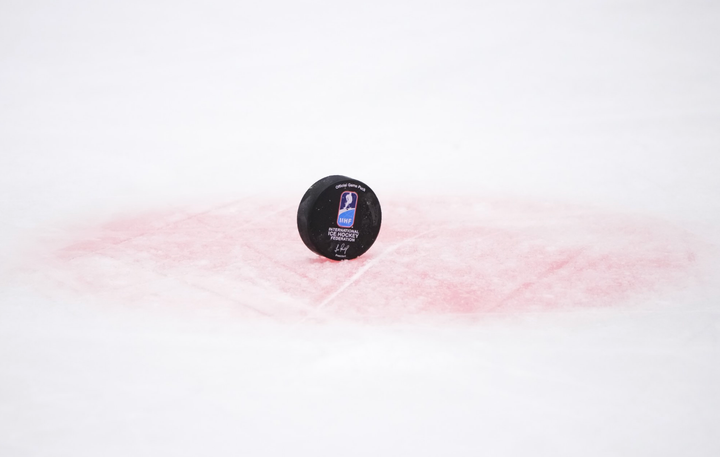Reflecting on two of women’s hockey’s best: A final farewell to Jocelyne and Monique Lamoureux
An average ode to two very stellar careers
Back in 2010, before there was ever a thrilling shootout winner or last-effort game-tying goal in an Olympic final, before the line brawls on the road to Sochi and the unyielding stand against USA Hockey, before the heartbreak of Olympic silver or the boundless joy of gold, there was a goal.
Jocelyne Lamoureux collected the puck inside the blue line, tossed it to her backhand, slipped it behind her back and between her legs and sidestepped the defender in one motion, and promptly deposited it behind the goaltender into the net.
I was new to women’s hockey at the time, but I was done for after that. I was a teenager with, notably, not a speck of athletic ability, and I’d never really tuned into a game before then. And the stakes, to be clear, weren’t that high. Team USA was playing a preliminary round game against China in the Olympics in 2010, the score was lopsided as always, and there was little doubt that they’d go on to meet Canada in the final (they did, and eventually lost).
Still, this was the moment that made me fall in love with women’s hockey.
You probably came here to read some words about Monique and Jocelyne, not about what I was doing when I got home from school in the tenth grade. But the thing about it is, if you untangle the knotted threads that weave across the stories I’ve written and the paths I’ve trodden from rink to rink, and you follow them all the way back, that’s the moment you come to. That’s where it all started for me. A Lamoureux goal.
And I know it’ll probably be a different goal, from a different moment, but there are thousands of girls across the country who are going to have the time of their lives playing this sport, have their hearts broken and repaired and broken again by this sport, and years down the line when they untangle those threads themselves, they’ll be able to point back and say that that’s where it all started for them.
A Lamoureux goal.
I can’t speak for Jocelyne and Monique. But knowing how hard they’ve worked to create a better, easier, more meaningful future in women’s hockey for every single one of those girls, I’ve got to imagine that means the world.
There aren’t words big enough to sum up the careers of these two. I’m failing just by virtue here. The Lamoureux twins have dominated the sport literally from before I started watching, up until their very last tournament with Team USA.
Since breaking in with the national team 15 years ago, their skill was undeniable and the punch they packed was foreboding. Their hockey careers are defined by this, crescendos of brilliance punctuated by the unflinching staccato of hard-nosed play, coldblooded scoring balancing out burning intensity, all of it underscored by the low hum of the drive to compete and be better.
They were not immovable so much as they forced others to move along with them, turning the tides of games and shifting the landscape of the sport.
Monique and Jocelyne did this at every stage of their careers, from the days when they brought home the first national titles for the Shattuck-St. Mary’s prep program to their time at the University of North Dakota, where they put the team on the map in the juggernaut WCHA.
Within one season, they led North Dakota to their first-ever WCHA Final Faceoff. (I’ve already told you my favorite Jocelyne goal; if you want to know my favorite Monique goal, look no further than her end-to-end rush in overtime of a make-or-break game three in the WCHA quarterfinals). By the end of their college careers they’d taken UND further than ever into the postseason, playing for the WCHA championship twice and going toe to toe with Minnesota, the best NCAA team in history, in a triple-overtime thriller in the 2013 NCAA Tournament quarterfinals.
College hockey is kind of my scene around here, and the thing that I love most about it is that, while many players fall short of winning championships, basically all of them leave an unmistakable imprint on their teams in their four years. Taking home a trophy is a surefire way to cement your place in history, but if you can’t do that, you can still come to the rink every day, do the work, have some fun, and leave the place better than you found it.
Throughout their collegiate careers, Jocelyne amassed enough points to rank within the top four all-time in NCAA history. Monique amassed enough minutes on defense to last any other player a lifetime. And the penalties. Let’s not even get started on the penalties. Still, there is no statistical category that can properly measure the impact they made in Grand Forks and at UND.
They did more than just leave the place better than they found it. The example they set was lasting; for years afterwards, people who passed through the program would dare to hold themselves to a higher standard and strive to reach greater heights because of it.
I know, because one of those people was me.
While their college careers were wrapping up, Monique and Jocelyne helped usher in an unprecedented era of success for USA Hockey. Despite coming up short at the 2014 Olympics in heartbreaking fashion and settling for silver again, Team USA amassed five straight Women’s World Championship titles from 2013-2019.
Still, those gold medals were arguably not the greatest victory over that timeframe. The story of the U.S. Women’s National Team boycott in 2017 is well-known by now. The players sought equitable compensation, investment, and programming from USA Hockey, and were willing to give up a chance at a gold medal on home soil to get it.
Like every other player who ignored a call from USA Hockey (or picked up the phone to say no), this is forever a part of the Lamoureuxs’ legacy. They ignited a movement that brought together players from every pocket of the country to create meaningful change. They did it at great risk to themselves and with the knowledge that the benefits of their success would be reaped, more than anyone else, by players who had yet to ever pull on a USA jersey.
They did succeed, of course. They won compensation and training stipends that accurately reflect the time and effort it takes to be a national team player. They won equitable per diem and bonuses and other benefits, like maternity leave. They won more frequent programming and resources dedicated to marketing the women’s and girls’ teams.
And soon after the Lamoureuxs helped achieve all of that, they found out the University of North Dakota was eliminating its women’s hockey program.
No two players had put more bricks in place to build the program at UND than Jocelyne and Monique. It only took one swift decision for that work to come undone.
This is the precariousness of our sport. You win your toughest battle one day and wake up the next and realize you’re still barely off the starting line. This is not by accident; we’re in this position because for a very long time, women’s hockey players have been undervalued, overextended, and underfunded.
Besides a stint on Monique’s part with the Boston Blades in 2014-15 and some games for both players with the Minnesota Whitecaps pre-NWHL, the two never played professional hockey. They were certainly never compensated as elite professional athletes, with playing opportunities or salaries that resembled those of their counterparts on the men’s side. The contract they hammered out with USA Hockey was groundbreaking, but the benefits it offers are limited to the players within the national team pool. In 2021, there is no other way for a professional women’s hockey player to make a living wage playing this sport in North America.
Sometimes, stories are defined as much by what’s left off the page as what’s on it. And that’s certainly what stands out to me about the Lamoureux twins’ careers. I think about what’s missing, the gaps between the highlight-reel moments that are filled with what-could-have-beens. They are far from the only players with careers marked by these missing pieces. Every one of those gaps was born from the mindset that this can be a once-every-spring or once-every-four-years sport. What I think is important to remember is that that has never been true for the people who play it.
After graduating college, Monique and Jocelyne trained every day for hours. They didn’t slow down; in fact, they worked harder to keep pushing and stay at the tops of their games. They were on the ice and at the gym constantly, juggling drills and workouts around full-time jobs.
So those deadened pauses throughout their careers are not there because they ever stopped playing, but because we weren’t there to see them. We gave them no real stage to perform their magic. Their tricks were not so simple and predictable as pulling rabbits out of hats; instead, we asked them to pull entire flourishing careers out of the darkened corners of rinks in the forgotten hours of the day. We have asked this of almost every girl or woman who puts on skates and has the audacity to graduate college and continue playing. When will we stop asking?
I’ve heard a lot of people use the word “bittersweet” in describing Jocelyne and Monique’s retirement, and I think it’s an accurate statement, although for a different reason. It’s sad thinking I’ll never watch them play again. It’s infinitely harder knowing that two generational players have reached the end of their road, after fighting so hard for fair and equitable opportunities, and there is still no way for a women’s hockey player to make a living solely as a professional athlete.
Even in retirement I am wholeheartedly sure that they won’t stop pushing to make things better, to make things right, to make sure that the bricks that are carefully laid don’t unceremoniously come undone. Still, there’s a shift now in who bears the brunt of that burden. To what extent will we lessen it, now that they’re gone? Or will we watch as yet another generation of players struggles to balance the weight of it?
The most memorable moments in both Lamoureux twins’ careers came in the last game of the last tournament they’d play for Team USA. If you made it this far in, I’m assuming you know the story by now. But if you don’t, read this and this and definitely watch this.
The 2018 Olympic final, to me, was a manifestation of everything that stands out about the two of them as players and competitors. When Team USA was back on its heels, reeling from yet another punch from Canadian captain Marie-Philip Poulin and staring down a 2-1 deficit in the third period, Monique punched back, tying it on a breakaway with less than seven minutes to go.
And in the sudden-death rounds of the shootout, it was Jocelyne who stepped up and pulled off a dazzling move, known forever now as “Oops, I Did It Again”, and when Maddie Rooney stopped Canada’s next shooter, the rest was literally history. The twins captured their Olympic gold medals the same way they’d done almost everything else in two decades of playing: through deft play-making and poise coupled with a healthy dose of sheer willpower.
The thing I really love about Jocelyne’s goal is that she pretty much refused to let it go down in history as a singular moment. From the minute they were asked about it postgame, her and Monique both enthusiastically called out their skills work with Peter Elander, one of their coaches at UND and an all-time great hockey mind. At the Olympics, in a shootout to win gold, you might only get one chance, but this was a move that they had practiced with Peter for years, until the ice wore thin underneath them and they had it just right.
The goal is clearly something special, iconic even; perfectly fitting for a once-every-four-years moment on the once-every-four-years Olympic stage. There are kids who have and will try and perfect it themselves, dreaming of pulling off their own “Oops, I Did It Again” in a once-every-four-years moment.
Some people might think inspiring those dreams is Monique and Jocelyne’s greatest legacy. But Jocelyne did not win her team an Olympic gold medal in a single moment. Nobody ever has, really. To me, their greatest legacy is this: they’ve lit a path that leads to a future in women’s hockey where players don’t have to choose between hockey and a livable wage, and kids don’t dream in four-year increments but every single day.
We’re not there yet. The work is largely unfinished, but the opportunities are endless and the pathway is there. We can replace the what-could-have-beens with what-can-bes. And when we tell the stories of historic careers, we can finally fill in the gaps and know there was nothing left off the page.





Comments ()